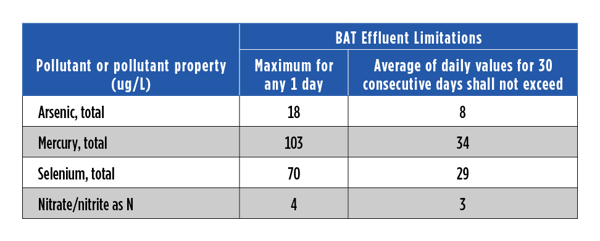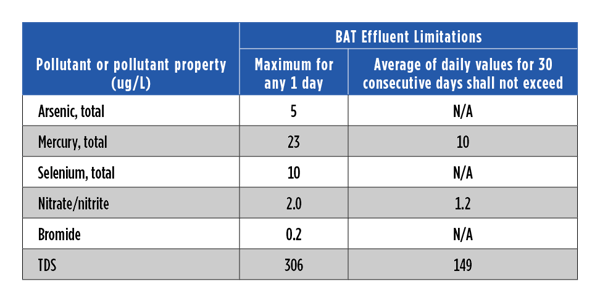While most likely not a surprise to operators of coal-fired power plants, new rules surrounding coal combustion residuals (CCR) and effluent limitation guidelines (ELG) will soon greatly impact the industry for the second time in recent years. The Final CCR Closure Part A Rule was published Aug. 28 in the Federal Register (FR) and goes into effect Sept. 28, altering many environmental standards plants need to meet to maintain regulatory compliance.
Plant owners have an immediate deadline of April 11, 2021, to initiate closure of unlined CCR impoundments — or impoundments not meeting location restrictions — or must request an extension from the Environmental Protection Agency (EPA) as soon as possible, but no later than Nov. 30, 2020. Several utilities are already developing extensions.
Named the 2020 Steam Electric Reconsideration Rule, the pre-publication version of the ELG rule was released Aug. 31. The latest guideline contains much of the same content as the rule proposed last December but includes additional reporting requirements for plants. The latest rule also shifts the focus to work with local authorities, rather than meeting federal guidelines, and adjusts discharge limits.
Regulating Limits
Under the ELG reconsideration, the “as soon as possible” date to meet regulations regarding flue gas desulfurization (FGD) and bottom ash transport water is one year after the rule is published in the FR, which is expected to happen this fall, while the “no later than” date is Dec. 31, 2025, as implemented in the National Pollutant Discharge Elimination System (NPDES) permit cycle. However, plants must comply with any applicable CCR deadlines, regardless of when FGD or bottom ash transport water requirements are implemented.
The updated requirements for FGD effluent are:
 Similar to the previous rule, the voluntary incentives program (VIP) provides plants with the option of more stringent requirements in exchange for an extended compliance schedule to meet necessary deadlines. Plants are required to meet these regulations by Dec. 31, 2028. VIP limits for FGD are updated to:
Similar to the previous rule, the voluntary incentives program (VIP) provides plants with the option of more stringent requirements in exchange for an extended compliance schedule to meet necessary deadlines. Plants are required to meet these regulations by Dec. 31, 2028. VIP limits for FGD are updated to:
 Operational Changes
Operational Changes
Bottom ash purge is still permitted, with a maximum of 10% of system volume purged on a rolling 30-day average for each plant. However, the actual purge volume allowed and any specific effluent limits will be established by state permitting authorities on a case-by-case basis. This update shifts the responsibility of determining compliance standards to state authorities rather than from an overarching federal guideline.
New Reporting Requirements
Under the new guidelines, plants face myriad updated reporting regulations for daily operations. Plants will now need to document and track the following items for their bottom ash sluicing systems: system volume calculations, list of potential discharges with assumptions, and information and calculations to determine expected volume and frequency of discharge. Additionally, a narrative describing all water treatment systems available at the plant now and in the future will need to be provided.
As part of the improvement process, plants will also have to provide a notice of planned participation (NOPP) to qualify for low-utilization status, meaning the plant is not operating at full capacity and will need to recertify annually based on a two-year average capacity utilization rate (CUR). This has changed from a megawatt-hour annual limit to a CUR of less than 10% tied to operating hours based upon the nameplate capacity of the facility. A best management practices plan will need to be established for any low-utilization boilers a plant operates. FGD wastewater generated under the low-utilization status will need to meet the below requirements potentially as soon as one year after publication of the rule in the FR but no later than December 31, 2023, as specified in their NDPES permit.
 Plants are also required to document any emergency or must-run orders that affect the plant’s low-utilization or retirement status. Additionally, plants will need to provide NOPP/annual progress reports demonstrating eligibility for VIP limits and notice of any transition between subcategories of operations occurring at the plant.
Plants are also required to document any emergency or must-run orders that affect the plant’s low-utilization or retirement status. Additionally, plants will need to provide NOPP/annual progress reports demonstrating eligibility for VIP limits and notice of any transition between subcategories of operations occurring at the plant.
Gas Conversion
The 2019 proposed regulations allowed an exemption for plants shutting down prior to 2028 to comply with the rule. The reconsideration clarified that facilities that cease operations on coal are eligible for the exemption. A NOPP filing is required for achieving permanent cessation of coal combustion by Dec. 31, 2028, to qualify as a plant eligible for this exemption.
For many coal-fired power plants, new regulations means making the difficult decision between implementing necessary technology upgrades to meet new EPA standards or shutting down the plant due to high costs associated with making updates. An experienced team can evaluate plant operations to determine the types of technology necessary to remain compliant while also developing a plan to help meet budgetary limitations.
Many bottom ash systems will soon be affected by changes in CCR management rules and ELG. Discover how a solution can be implemented to fit your facility.

